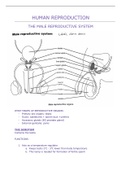Summary
Human Reproduction Summary - Gr11 & Gr12 IEB Mind Action Series Life Sciences
- Course
- Institution
- Book
A detailed, thorough and organised summary of the Human Reproduction chapter of the IEB Mind Action Series Life Sciences textbook. Class notes and diagrams are included throughout the summary. These notes helped me achieved my 86% final Bio exam mark in matric.
[Show more]




